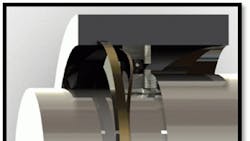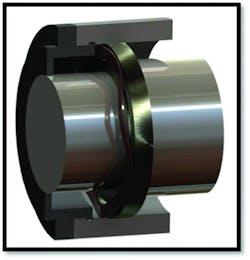Simplifying design: Spiral wound retaining rings
Three alternatives to traditional retainers are retaining rings, spiral rings, and wave springs. More compact than conventional hardware, these can work alone or in concert to fulfill functional design requirements while eliminating extraneous material (and therefore, cost.)
One ring application is bearing retention. When used in conjunction with wave springs (in situations requiring preload) they serve as a shoulder for the spring, and provide rigid and resilient endplay takeup.
Consider such one specific bearing-retention application in which the retainer must accommodate high axial loads and rotational speed.
Traditionally, such bearings are held in place with a combination of an endcap and wave spring. In contrast, substituting a spiral-wound multiple-turn wave spring allows 360° contact with entire periphery of groove, with no gaps — and because there are no lugs, there is a radial space savings.
Coiled versions also eliminate sharp edges, useful in certain designs.
In fact, by replacing the endcap with a multiple-turn spiral ring, the final application is streamlined while still accommodating the bearing's axial loads and high rpm. The shoulder is effectively created with minimal material and space.
Below, a closeup of the final installation is shown without the endcap. In steel or exotic alloys, the rings sport oil dip, black oxide, cadmium plating, passivation, or zinc phosphate finishes.
For more information, contact Joe Cappello at (732) 469-7333 or visit rotorclip.com.


